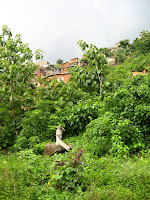En brousse



'En brousse' is French for in the bush, a term Peace Corps volunteers use to describe posts that are remote and fairly rough in terms of amenities, but it also refers to areas filled with vegetation but not rising to the level of 'jungle.' These are some photos of what 'en brousse' looks like (at least in the greener areas of the country). The girls pictured in the last photo are walking home for lunch from school -- they basically walk on a little path in the bush in their uniforms with their books on their heads to get to and from school. (By the way, they've paused because they're watching Paola, the photographer mentioned below, at work. I'm sure they could not imagine why this random white woman was out in the middle of nowhere taking pictures of plants).

















































